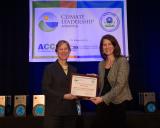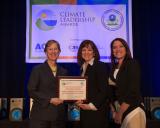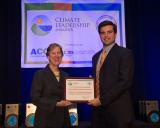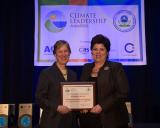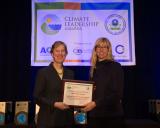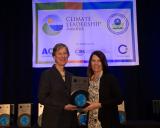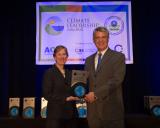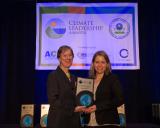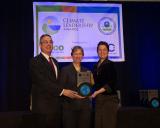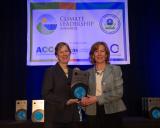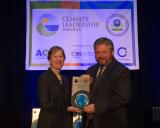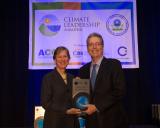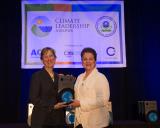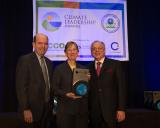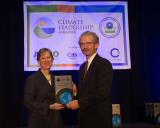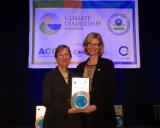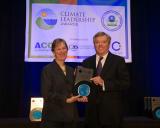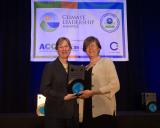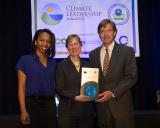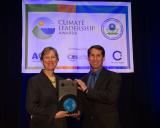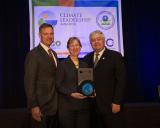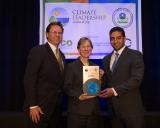2013 Climate Leadership Award Winners
 2013 award winners were publicly recognized during the awards dinner on February 28, as part of the Climate Leadership Conference, which was held in Washington, DC from February 27 - March 1, 2013.
2013 award winners were publicly recognized during the awards dinner on February 28, as part of the Climate Leadership Conference, which was held in Washington, DC from February 27 - March 1, 2013.
Organizational Leadership Award
- Boulder County, Colorado
- City of Austin, Texas
- Intel Corporation
- Port of San Diego
- Sonoma County Water Agency
Individual Leadership Award
- Tamara "TJ" DiCaprio, Senior Director of Environmental Sustainability, Microsoft Corporation
- J. Wayne Leonard, Former Chairman and CEO of Entergy Corporation (retired)
Supply Chain Leadership Award
Excellence in Greenhouse Gas Management (Goal Achievement Award)
- Abbott
- CSX Transportation, Inc.
- Limited Brands, Inc.
- Office Depot
- Raytheon Company
- Staples, Inc.
- Tiffany & Co.
- Turner Construction Company
Excellence in Greenhouse Gas Management (Goal Setting Certificate)
- Bank of America
- Lockheed Martin Corporation
- Science Applications International Corporation (SAIC)
- SC Johnson & Son, Inc.
- Wells Fargo & Company
Special Thanks to the CLA Judges
Organizational Leadership Award
Recognizes organizations that not only have their own comprehensive GHG inventories and aggressive emissions reduction goals, but also exemplify leadership in their internal response to climate change, through engagement of their peers, competitors, partners, and supply chain, and addressing climate risk in their enterprise strategies.
Boulder County, Colorado
Boulder County conducts government operations within a Colorado community of approximately 300,000 residents. Among the county's responsibilities are transportation, emergency preparedness and law enforcement, as well as other traditional local government services. Boulder is acknowledged as a leader on climate change issues within its region and its goals, implementation strategy, and stakeholder engagement, which should serve as a model for other counties across the country.
The County set an aggressive GHG reduction goal and has taken effective actions towards meeting it. Based on the Kyoto Protocol, they adopted a goal of reducing GHG emissions by 92 percent from 2005 to 2020. This goal is being addressed with energy efficiency assistance to more than 8,400 homes and 2,400 businesses, encouragement of bike sharing and other commuter projects, solar PV installations on county buildings totaling more than 900 kW, and development of strict energy efficiency requirements in county residential and commercial building codes.
Through implementation of partnership and education programs throughout the region, Boulder County has been able to garner additional public support for its efforts and increase the rate of GHG reductions. Boulder's "Energy Smart" program has had ripple effects in other parts of Colorado, which was evident at a Boulder County-led "Energy Efficiency" summit held in August 2012. Nearly two dozen businesses and organizations from other parts of Colorado shared best practices and strategies at the summit for continuing Energy Smart and similar program successes into 2013 and beyond.
In 2012, Boulder finalized its Climate Change Preparedness Plan, including goals for a disaster recovery plan, coordination of water resources management, hiring of a full time community wildfire protection planner, and development of a heat emergency plan. Boulder is also a member of the Western Adaptation Alliance, where Boulder's leadership is apparent as one of the few communities with a completed plan and list of action items.
City of Austin, Texas
The City of Austin is the capital of Texas and the seat of Travis County. The City has a workforce of more than 12,000 employees, operates over 500 facilities, and has a fleet of 4,695 vehicles. Like many cities, Austin operates in a budget-constrained environment, which makes its climate change commitments all the more impressive.
The foundation for the City's climate response actions is the 2007 Austin Climate Resolution to "make Austin the leading city in the nation in the effort to reduce the negative impacts of global warming." The five-point Austin Climate Protection Plan established mid-range goals to: make all city operations to be carbon-neutral by 2020; reduce total energy use to 800 MW, while increasing its renewable portfolio to 35 percent of its power mix; require energy efficiency measures in current homes, buildings, and new construction; increase collaboration for community-wide emission reductions; and provide tools such as emission offsets for city residents.
In 2012, the City achieved its previously stated 2007 goal of powering city-owned facilities with 100 percent renewable energy. Austin Energy, the city-owned electric utility, is a long-time "green" innovator and a key partner on the plan's implementation. By subscribing to Austin Energy's green power product, the City achieved its goal of powering all municipal facilities with 100 percent renewable energy by 2012. Despite the recession, the City of Austin has successfully made a business case for the switch to green power, therefore setting an excellent model for planning and deploying a city-wide climate change plan. The City has also provided climate change training to its workforce and implemented a number of programs to share best climate change practices with residents and partners.
With the City on track to achieving its municipal milestones, the Climate Program's next phase of work includes addressing community-wide GHG emissions and continuing to ensure that 2020 municipal goals will be met.
Intel Corporation
Intel designs and builds technologies that serve as a foundation for the world's computing devices. Intel has demonstrated its commitment to climate leadership not only by exceeding its most recent GHG reduction goal, but also by positively impacting emission reduction efforts with leadership in renewable energy purchases and energy efficient product design.
Intel exceeded its recent goal to reduce GHG emissions 20 percent below 2007 levels by the end of 2012, achieving a 60 percent reduction. Since 2008, Intel has been the largest purchaser of renewable energy in the U.S. The company's annual green power usage is now over 3 billion kilowatt-hours, or 100 percent of Intel's total annual U.S. electricity use. Through these renewable energy purchases, Intel is helping to create demand for wind, solar, and other renewable technologies that can help make the overall U.S. electricity supply cleaner. The company has also partnered with third parties to complete more than 18 solar electric installations (over 7,000 kW) across its campuses, in the U.S. and at sites in Israel and Vietnam.
By building energy efficiency directly into its products, Intel is also able to help its customers reduce energy use and GHG emissions. For example, in 2011, Intel worked with a major technology company to reduce emissions by lowering the number of servers needed through server virtualization. This company is saving an estimated 661 tons of CO2 emissions each year—478 tons from electricity savings, and 183 tons from chilled water production savings—through server virtualization.
The company has fostered a culture of climate leadership. Their GHG reduction activities, and the substantial impacts from Intel's products and renewable energy purchases, make Intel a model of organizational leadership by a large corporation.
Port of San Diego
The Port of San Diego is the fourth largest of the 11 ports in California. The Port has invested millions of dollars in public improvements in its 5 member cities—Chula Vista, Coronado, Imperial Beach, National City, and San Diego. It is an economic engine, a provider of community services, and an environmental steward and innovator. Along with its GHG reduction goals and progress towards those goals, the Port has been a model of collaboration on a regional scale and has induced external change by taking advantage of the nodal role of the port.
The leadership of the Port starts with the establishment of its own GHG reduction activities. The Port adopted a sustainability policy and established the Green Port Program in 2008. By 2011, it had achieved a 15 percent reduction in GHG emissions. To achieve these reductions, the Port completed energy efficiency audits of Port facilities, installed 170 kW of solar panels, added CNG and hybrid vehicles to its fleet, installed 10 electric vehicle charging stations, educated Port staff, established a commuter assistance program for employees, and conducted LED pilot projects. These efforts resulted in over $176,000 in utility savings since the start of the Green Port Program, reinforcing the value of energy efficiency and mitigation to budget-constrained public entities.
In addition to its own GHG reduction activities, the Port has established goals of reducing emissions through the full lifecycle of operations, including emissions in its supply chain and those generated by businesses operating at the Port. In 2012, the Port set a goal of reducing GHG emissions from all activities within its jurisdiction 10 percent from a 2006 baseline by 2020 and 25 percent by 2035. One way it is striving to achieve these goals is through the creation of a Green Business Network for its waterfront businesses—ranging from cargo and cruise terminals to shipyards, hotels, and marinas.
In 2011, the Port served as the committee chair for a regional collaboration that resulted in the award-winning Sea Level Rise Adaptation Strategy for San Diego Bay (SLR Adaptation Strategy). As the first regional sea level rise planning effort of its kind, the SLR Adaptation Strategy not only provides participating jurisdictions with policy recommendations and tools to make their bay-front communities more resilient to sea level rise, but also serves as a model for other regional climate change planning efforts. The Port is also chairing and leading the effort to form the Climate Collaborative - San Diego Region to raise awareness and understanding of the climate change adaptation and mitigation activities taking place in the San Diego region and promote community and decision-maker engagement.
Sonoma County Water Agency
The Sonoma County Water Agency provides naturally filtered drinking water, flood protection services, distribution of recycled water, recreational opportunities, and wastewater treatment to over 600,000 residents of Sonoma and Marin counties in California. In addition, the Agency serves as the regional leader in climate change mitigation and adaptation by developing innovative governance frameworks, policy, programs, and projects to increase energy efficiency, develop renewable energy, and reduce greenhouse gases.
In 2006, the Agency committed to an aggressive goal of operating a carbon-free water system by 2015. Efforts to achieve this goal include: leading a county-wide local government electric vehicle effort; initiating Property Assessed Clean Energy (PACE) program financing for clean energy projects; and, more recently, developing a Community Choice Aggregation program as a means to facilitate distribution and development of renewable energy county-wide.
The Agency's efforts expand beyond the scope of the water system. Locally, the Agency leads the Sonoma County Efficiency Financing Program to aggregate and fund energy and water efficiency upgrades at schools and public buildings county-wide. Additionally, the Agency formed the "North Coast Integrated Regional Water Management Plan," a seven-county coalition to collectively plan regional water projects and identify ways to advance renewable energy development as a region through projects such as biomass energy. At the state level, senior staff from the Agency serve in various leadership roles in state-wide coalitions such as the California Environmental Dialogue, a non-profit organization which brings together government and business to discuss long-range aspects of the State's environmental issues.
Nationally, the Agency initiated, helped establish, and supports Applied Solutions—a non-profit network of counties and cities that identify and share innovative clean energy projects, programs, and financial mechanisms.
Individual Leadership Award
Recognizes individuals exemplifying extraordinary leadership in leading their organizations' response to climate change and/or affecting the responses of other organizations.
Tamara "TJ" DiCaprio
Tamara "TJ" DiCaprio is the Senior Director of Environmental Sustainability at Microsoft, a global IT software and services company with 90,000+ employees operating in more than 100 countries.
TJ led the effort to establish Microsoft's recent commitment to carbon neutrality for its data centers, software development labs, offices, and employee air travel. A key component of this aggressive GHG reduction policy is an internal carbon fee, which provides an innovative approach to voluntary operational accountability and is already helping to change behavior. Internalizing the cost of pollution through financial measures offers greater incentives to reduce emissions while raising funds for efficiency and renewable energy projects, helping to advance measures to mitigate climate change.
In order to design and implement this new carbon fee model, TJ worked with senior executives across Microsoft to build a compelling business case that convinced Microsoft's CFO to adopt and support this critical measure. Microsoft's use of an internal carbon fee is now serving as a model for other Fortune 500 companies and public sector organizations considering new GHG reduction strategies, including increased use of renewable energy.
TJ was also responsible for leading Microsoft to achieve its goal of reducing carbon emissions by 30 percent per unit of revenue from 2007 levels by 2012 through a series of efficiency initiatives and purchasing renewable energy. As a result of her vision and efforts, Microsoft purchased 1.1 billion kilowatt-hours (kWh) of green power in 2012, making Microsoft the third largest purchaser of green power in the United States.
J. Wayne Leonard
J. Wayne Leonard recently retired as the Chairman and Chief Executive Officer of Entergy Corporation, an integrated energy company headquartered in New Orleans that is engaged primarily in electric power production, retail distribution operations, and wholesale electric energy sales.
Under Wayne's leadership, Entergy established and achieved 3 voluntary GHG reduction goals to stabilize Entergy's CO2emissions at or below year 2000 levels. The most recent goal established a 20 percent reduction below year 2000 levels to be achieved by 2020. He led the adoption of a comprehensive 10-year environmental strategy to manage climate risks, accelerate clean energy generation, increase energy efficiency, and support "multiple lines of defense" to build preparedness and resilience.
Outside of Entergy, Wayne is an active and visible leader on climate change response, including being outspoken on the moral dimensions of climate change. He has leveraged his position to collaborate extensively with government and NGO leaders on climate change policy. He has personally advocated for climate legislation and adaptation planning by meeting with numerous government officials at state and Federal levels, delivering keynote addresses about climate change, and authoring articles and op-ed pieces on the importance of climate response. Wayne also launched the "Coastal Resilience Strategy" to help stakeholders build more resilient communities and to share best practices.
Wayne has earned respect as a strong leader, showing resolve at the highest organizational level. He is a passionate climate change advocate for efficient, effective, and equitable policies that manage risk and move his company, community, and country toward a clean energy future.
Supply Chain Leadership Award
Recognizes organizations that have their own comprehensive GHG inventories and aggressive emissions reduction goals and demonstrate they are at the leading edge of managing GHGs in their organizational supply chains.
Cisco Systems, Inc.
Cisco Systems, Inc. designs, manufactures, and sells internet protocol-based networking and other products related to the communications and information technology industry, and provides services associated with these products and their use. Cisco has consistently been a leader on supply chain sustainability, and its work has evolved over the last several years to become the comprehensive program being recognized.
Annually since 2010, Cisco's Vice President of Supply Chain Operations has sent a letter to the company's suppliers, requesting they report to the Carbon Disclosure Project (CDP), while also outlining Cisco's own carbon management goals. The company's long-term objective is for all suppliers (and their business partners) to publicly report to CDP and set their own goals. GHG emissions reporting and goal-setting are integrated into Cisco's supplier business scorecard, along with other environmental criteria such as water and waste. Cisco collaborates with suppliers to help them meet those expectations and uses third-party audits to ensure that suppliers' management systems are capable of monitoring their environmental impacts. Suppliers that publicly report to CDP are favored in the scoring process, and those that score well are more likely to receive business from Cisco in the future, while Cisco works with low-scoring suppliers to help them improve.
Cisco's external collaboration on GHG supply chain management further illustrates the company's leadership in this field. Along with the company's longtime reporting to CDP, Cisco is involved in a joint project between the Electronic Industry Citizenship Coalition, the Massachusetts Institute of Technology, and the International Electronics Manufacturing Initiative to develop supply chain data collection techniques for major electronics commodities for carbon footprinting purposes. Coupled with Cisco's own lifecycle analysis efforts, which embed measures that reduce GHG emissions into Cisco's product design requirements, Cisco demonstrates leadership on product GHG emissions.
Cisco has also achieved a 25 percent absolute reduction goal by 2012 from a 2007 baseline, including business air travel scope 3 emissions. The company is looking to further reduce scope 1-2 and business-air-travel scope 3 emissions worldwide on an absolute basis 15 percent by 2017.
IBM
IBM is a global company that provides integrated solutions leveraging information technology and knowledge of business processes to assist clients in solving business problems, transforming operations (e.g., energy management, data centers, facilities, asset management, power systems), business processes and infrastructures—making them more efficient.
In 2010, IBM communicated a set of new corporate responsibility and environmental management requirements for its more than 27,000 first-tier global suppliers. Suppliers must "define, deploy, and sustain" a management system to effectively address the suppliers' business intersections with the social and environmental responsibilities listed in IBM's Supplier Conduct Principle and the Electronic Industry Citizenship Coalition (EICC) Code of Conduct. IBM requires suppliers to measure their performance, and at a minimum, in the areas of energy conservation, scope 1 and scope 2 GHG emissions, and waste management; set voluntary environmental goals to achieve positive results in reducing operational impacts; publicly disclose their performance; and cascade IBM's requirements to their own suppliers. This is a strong, comprehensive approach to embedding expectations of GHG management deep within their supply chain.
IBM also leads on supply chain sustainability through involvement in partnerships and associations designed to advance the field. IBM was instrumental in initiating the EICC Environmental Working Group (EWG) in 2009 to expand EICC's focus on environmental performance of the electronics supply chain. To encourage wide adoption of energy use and GHG emissions disclosures, the EWG developed a flexible, low-cost, and easy-to-use spreadsheet for EICC suppliers if they did not already use an established disclosure platform. IBM also participated in the CDP Supply Chain Project from its inception in 2008 through 2011, and consistently achieved one of the best participation rates in the CDP Supply Chain project during its participation with over 87 percent of their invited suppliers responding in 2011.
IBM set a second generation operational CO2 emissions reduction goal of a 12 percent absolute reduction by 2012 from a 2005 baseline. As of year-end 2011, IBM's energy conservation results and procurement of renewable energy resulted in a 16 percent reduction in operational CO2 emissions as compared to the baseline year.
San Diego Gas & Electric Co.
San Diego Gas & Electric Co. (SDG&E) is a regulated public utility that provides energy service to 3.4 million people through 1.4 million electric meters and 855,000 natural gas meters in San Diego and southern Orange counties in California.
SDG&E has demonstrated supply chain leadership both externally and internally. In 2010, SDG&E began including sustainability questions in most of the utility's high-value Requests for Proposals, and in 2012, the company began to give those questions weight in contract award decision making. SDG&E has also collaborated with suppliers to use more responsible products, including the increased use of waste fly ash in concrete, environmentally friendly utility poles, and right-sized lengths of electrical cable. Internally, SDG&E has engaged employees through measures such as a the establishment of green goals for all supply management staff, implementing a minimum order requirement to reduce packaging and transportation, and Department Sustainability Awards, which recognize notable achievements in supply chain sustainability. SDG&E has developed a mature governance structure for supply chain sustainability, creating a Supply Chain Manager position to oversee SDG&E's Supplier Relationship Management and Supply Chain Sustainability programs, a Supply Management Sustainability Team, and a Sustainable Purchasing Policy.
SDG&E has also created a GHG reduction goal, aiming for a 20 percent intensity reduction by 2016 from a 2010 baseline. To meet this goal, SDG&E will continue to invest in renewable energy and end its only remaining contract with a coal-fired power plant. SDG&E has shown commitment to low-carbon energy sources beyond state mandates, growing its contracts for renewable energy from 550 GWh in 2003 to 3,380 GWh in 2011. SDG&E has also continued to make progress on a goal to reduce fleet vehicle emissions 15 percent by 2012 compared to a 2007 baseline of 20,179 metric tons of CO2e.
Excellence in Greenhouse Gas Management (Goal Achievement Award)
Recognizes organizations that publicly report and verify corporate GHG inventories and achieve aggressive GHG emissions reduction goals.
Abbott
As one of the world's largest diversified health care companies, Abbott serves people in more than 150 countries with science-based diagnostics, medical devices, nutritionals, and branded generic pharmaceuticals.
As part of company-wide efforts to reduce its environmental impact, Abbott adopted a goal of reducing global GHG emissions by 5 percent from 2009 to 2015 under the EPA's former Climate Leaders program. By the end of 2011, Abbott had surpassed this goal by achieving a 6.4 percent reduction.
Abbott achieved these absolute reductions through a combination of utilizing renewable and co/tri-generation energy, switching fuels, and increasing the efficiency of energy and industrial processes at production facilities. These reduction strategies make the everyday operation of the company's facilities more efficient, reduce emissions, and save money at the same time.
This was Abbott's second completed goal set under the Climate Leaders program; the company achieved its initial goal of reducing GHG emissions in the U.S. by 17 percent from 2006 to 2009.
CSX Transportation, Inc.
CSX Transportation, Inc. operates the largest railroad in the eastern United States, with a rail network linking commercial markets in 23 states, the District of Columbia, and two Canadian provinces. Given that locomotive operations are CSX's largest driver of fuel use and GHG emissions, the company is committed to further improving its fuel efficiency.
In mid-2007 as part of the EPA's former Climate Leaders program, CSX set a goal of reducing its U.S. GHG emissions intensity by 8 percent per revenue ton-mile from 2006 to 2011. The company achieved its goal in 2010, one year early, ultimately resulting in a 17 percent absolute reduction in emissions. Consistent with the rail industry transportation standard for reporting and tracking fuel use associated with the movement of freight, CSX normalizes its annual GHG emissions data based on metric tons of CO2e per million revenue ton-miles.
CSX's achievement was driven by modernizing the locomotive fleet, comprehensive training for engineers, and technological improvements to locomotives. Use of the Event Recorder Automated Download (ERAD) Program helps improve operator efficiency, while idle reduction technologies and friction modifiers improve locomotive fuel efficiency. Additionally, CSX has added 30 fuel efficient GENSET Locomotives to its fleet in the past 5 years.
Limited Brands, Inc.
Limited Brands, Inc. is a specialty retail business focused on women's intimate apparel, beauty, and personal care product categories. The brands that make up the organization are Victoria's Secret, Victoria's Secret PINK, Bath & Body Works, La Senza, and Henri Bendel.
Under the EPA's former Climate Leaders program, Limited Brands established a goal of reducing total U.S. GHG emissions by 3 percent from 2007 to 2014. Limited Brands achieved and exceeded its goal 3 years early. By 2011, Limited Brands reduced absolute emissions by 6.3 percent – double the original goal.
To achieve this goal, Limited Brands employed energy efficiency strategies at their stores and home offices, installing more efficient lighting, adjusting temperature set points, and making improvements to buildings. Additionally, Limited Brands implemented a "No Idle" policy for vehicles on its campuses, reducing scope 1 emissions and providing a public health benefit through reduced air pollution.
Office Depot
Office Depot provides office supplies and services through more than 1,675 worldwide retail stores, a dedicated sales force, catalogs, and global e-commerce operations. Office Depot has annual sales of approximately $11.5 billion, employs about 39,000 associates, and serves customers in 60 countries around the world.
In 2010, under the EPA's former Climate Leaders program, Office Depot adopted a goal of reducing U.S. GHG emissions by 20 percent from 2007 to 2012. In 2011, Office Depot accomplished its goal one year early by achieving a 29 percent reduction in absolute emissions.
Office Depot has invested in energy efficiency and green building initiatives since 2004. In 2011, Office Depot completed a major de-lamping effort, installed motion detectors in receiving areas, and continued to upgrade HVAC systems. The company reduced annual electricity consumption in its North American facilities from 666,000 MWh in 2005 down to 499,000 MWh in 2010, notwithstanding an increase in facility square footage under management.
Raytheon Company
Raytheon Company is a technology and innovation leader specializing in defense, homeland security, and other government markets worldwide. Raytheon provides state-of-the-art electronics, mission systems integration, and other capabilities in the areas of sensing; effects; and command, control, communications and intelligence systems, as well as a broad range of mission support services.
Under the EPA's former Climate Leaders program, Raytheon set a goal of reducing total U.S. scope 1 and 2 GHG emissions by 10 percent from 2008 to 2015. Raytheon achieved a 16 percent reduction in scope 1 and 2 emissions by the end of 2011, meeting its goal several years ahead of schedule and exceeding its 10 percent reduction goal.
As 90 percent of Raytheon's GHG emissions were due to energy use, the company pursued an aggressive energy conservation program, implemented numerous energy efficiency projects throughout the company, and purchased renewable energy accounting for 4 percent of the company's total electricity use in 2011. Additionally, Raytheon worked to reduce manufacturing processes emissions from high global warming potential GHGs, such as perfluorocarbons, hydrofluorocarbons, and sulfur hexafluoride.
This goal is Raytheon's second completed goal. The company achieved its initial goal by reducing U.S. GHG emissions by 38 percent per dollar revenue from 2002 to 2008 under Climate Leaders.
Staples, Inc.
Staples, Inc. is among the world's largest office products companies and internet retailers. Staples offers office supplies, technology products and services, facilities and breakroom supplies, furniture, copy and print services, and a wide range of other product categories. Headquartered outside of Boston, Staples operates throughout North and South America, Europe, Asia, Australia, and New Zealand.
In 2003, Staples established a goal of reducing total U.S. GHG emissions by 7 percent from 2001 to 2010 under the EPA's former Climate Leaders program. Staples exceeded its goal to cut its absolute U.S. GHG emissions, despite significant growth and acquisitions. The total U.S. GHG emissions were reduced 30 percent.
The goal was achieved through various energy reduction initiatives in Staples' facility and delivery fleet operations, and the aggressive use of renewable energy sources. Staples' energy efficiency efforts include: 1) creating a culture of energy awareness through ENERGY STAR® initiatives such as the ENERGY STAR® Challenge; 2) optimizing energy systems through enhanced EMS and recommissioning programs; and 3) investing capital to keep stores, distribution centers, and offices on the forefront of cost-effective lighting, HVAC and controls technologies. These energy efficiency improvements, along with renewable generation technologies and fuel savings realized in Staples' fleet, have been key to helping Staples meet and exceed its commitment to cut its absolute carbon footprint.
Tiffany & Co.
Tiffany & Co. is a holding company that operates through its subsidiary companies. The principal subsidiary, Tiffany and Company, is a jeweler and specialty retailer. The Company is engaged in product design, manufacturing, and retailing activities. In 2011, Tiffany operated more than 240 stores across 22 countries.
Under the EPA's former Climate Leaders program, Tiffany & Co. established a goal of reducing U.S. GHG emissions by 10 percent per square foot from 2006 to 2011. Tiffany & Co. reduced U.S. GHG emissions per square foot by 14.7 percent, exceeding its goal and achieving an absolute GHG reduction of almost 5.9 percent.
Tiffany & Co. accomplished these reductions by implementing energy efficiency projects including lighting retrofits, the installation of energy recovery ventilators and heating, and ventilation and air conditioning improvements.
Turner Construction Company
Turner Construction Company is a leading general builder in the U.S. with 5,000 employees working on more than 1,200 projects each year. Along with being a participant in the green building market, Turner Construction has worked to reduce its own GHG emissions.
Turner Construction established a goal of reducing total U.S. GHG emissions by 5 percent from 2006 to 2011 under the EPA's former Climate Leaders program. The company exceeded its goal in 2011, with a reduction of almost 6 percent.
Turner Construction Company achieved its goal primarily through reducing electricity use at permanent offices. In addition to renovating its Toledo, OH office, which received LEED Silver certification in 2007, the company implemented strategies to further improve energy efficiency through employee engagement. Among the strategies employed was the installation of interactive dashboards in several offices that display energy use in real time and allowed employees to see current use and patterns of use as well as compare energy use to that of other Turner offices. A second strategy involved a pilot test where devices were installed at outlets to monitor plug load energy use. Plug load energy data was monitored and reported to employees so that they could be aware of how much energy they consumed and which devices consumed the most energy. Conservative scheduling of all devices (to automatically turn off during non-business hours) resulted in a 33 percent reduction in plug load energy use. Additionally, the company asked offices and project sites to complete a "Turner Green Zone" checklist to raise awareness of ways to improve energy performance among other issues and to encourage friendly competition on Turner's internal website.
Excellence in Greenhouse Gas Management (Goal Setting Certificate)
Recognizes organizations that publicly report and verify corporate GHG inventories and publicly set aggressive GHG emissions reduction goals.
Bank of America
Bank of America is one of the world's largest financial institutions, serving individual consumers, small and middle market businesses, and large corporations with a full range of banking, investing, asset management, and other financial and risk management products and services.
In 2011, Bank of America announced a goal of reducing global scope 1 and scope 2 GHG emissions by 15 percent from 2010 to 2015. The company plans to achieve this goal through energy efficiency measures. The measures include capital projects on office spaces, improvements to data center efficiency, and over 200 low-cost specific operational improvements such as reduced operating hours and chilled water retro-commissioning.
This goal is Bank of America's second GHG reduction goal. Under the EPA's former Climate Leaders program, the company exceeded its initial goal of reducing total U.S. GHG emissions nine percent from 2004 to 2009 by achieving an 18 percent reduction.
Lockheed Martin Corporation
Headquartered in Bethesda, Maryland, Lockheed Martin Corporation is a global security and aerospace company that employs about 120,000 people worldwide and is principally engaged in the research, design, development, manufacture, integration and sustainment of advanced technology systems, products, and services.
Lockheed Martin recently adopted a new goal of reducing global scope 1 and 2 GHG emissions by 35 percent from 2010 to 2020. The company plans to use a real-time energy measurement and management tool that has already been employed in pilot projects to better manage the energy consumed in the company's 40 largest GHG-emitting facilities. Additionally, Lockheed Martin will focus on HVAC infrastructure improvements, as a typical company facility devotes over 50 percent of its energy usage to HVAC.
Lockheed Martin's current goal for reducing GHG emissions follows the company's recently announced achievement of reducing absolute, global GHG emissions more than 25 percent from 2007 through 2012. Lockheed Martin achieved its initial goal by reducing U.S. GHG emissions 30 percent per dollar revenue from 2001 to 2007. Both previous goals were established under the EPA's former Climate Leaders program.
Science Applications International Corporation
Science Applications International Corporation (SAIC) is a scientific, engineering, and technology applications company headquartered in McLean, VA that uses its knowledge to solve problems in national security, energy and environment, health, and cybersecurity.
On October 11, 2011, SAIC's CEO announced a goal of reducing global scope 1 and 2 GHG emissions by 25 percent from 2010 to 2020. As the owner of 20 percent of its office space, SAIC plans to reduce emissions by disposing of real estate assets that are either underperforming or underutilized and consolidating other spaces for a net reduction in square footage. SAIC will also pursue energy efficiency projects in its office spaces, educate employees, and raise awareness about the contributions they can make to reducing energy use.
SC Johnson & Son, Inc.
SC Johnson & Son, Inc. is a leading manufacturer of household cleaning products and products for home storage, air care, pest control, and shoe care. SC Johnson is a family-owned and managed business dedicated to innovative, high-quality products, excellence in the workplace, and a long-term commitment to the environment and the communities in which it operates.
SC Johnson announced a goal of reducing U.S. GHG emissions by 7 percent from 2010 to 2015. The company's goal will be achieved primarily through increased use of renewable energy. SC Johnson recently began operating two wind turbines at its Racine, WI facility and mini-wind turbines and solar applications at other factories, in the U.S. and around the globe. Additionally, SC Johnson will explore more opportunities to purchase renewable energy in the U.S. as it has already done at its Bay City, MI factory.
This goal is SC Johnson's third GHG reduction goal. Under the EPA's former Climate Leaders program, the company achieved a second goal by reducing total U.S. GHG emissions by 8 percent from 2005 to 2010 and its initial goal by reducing total U.S. GHG emissions by 17 percent from 2000 to 2005. Combined, the absolute GHG emission reductions were reduced 26 percent from 2000.
Wells Fargo & Company
Wells Fargo & Company is a nationwide, diversified, community-based financial services company with $1.4 trillion in assets. Wells Fargo provides banking, insurance, investments, mortgage, and consumer and commercial finance services through more than 9,000 stores, 12,000 ATMs, and wellsfargo.com, and has offices in more than 35 countries. Wells Fargo's goal is part of the operational pillar within the company's renewed comprehensive commitment to investing in environmental solutions for stronger communities.
Wells Fargo adopted a new goal of reducing U.S. GHG emissions by 35 percent from 2008 to 2020, including all scope 1 and 2 emissions, and scope 3 business air travel emissions. The company intends to meet this goal with energy efficiency improvements to its office space and data centers. In addition, Wells Fargo plans to consolidate office space, reducing the total number of square feet.
Wells Fargo's goal significantly expands on its initial goal of reducing U.S. GHG emissions by 20 percent from 2008 to 2018 under the EPA's former Climate Leaders program.
Special Thanks
The Climate Leadership Awards Steering Committee would like to thank the following individuals for their dedication and support of the program:
Judges for the Excellence in Greenhouse Gas Management Categories:
- Peggy Foran – The Climate Registry
- John Sottong – U.S. Environmental Protection Agency
Judges for the Supply Chain Leadership Category:
- Cheryl Bynum – U.S. Environmental Protection Agency
- Cynthia Cummis – World Resources Institute
- Andre De Fontaine – U.S. Department of Energy
- Chrystina Gastelum – Carbon Disclosure Project
- Nancy Gillis – U.S. General Services Administration
- Melissa Klein – U.S. Environmental Protection Agency
- Stan Rhodes – SCS Global Services
- Nick Shufro – PwC
- Marco Ugarte – Sustainability Consortium
- Susan Wickwire – U.S. Environmental Protection Agency
Judges for the Organizational and Individual Leadership Categories:
- Chris Baglin – Project Performance Corporation
- Matt Banks – WWF Climate Savers
- Mike Bellamente – Climate Counts
- Tom Carnac – Carbon Disclosure Project
- Cheri Chastain – Sierra Nevada Brewing
- Matt Clouse – U.S. Environmental Protection Agency
- Jay Dietrich – IBM
- Pam Fair – San Diego Gas & Electric
- Steve Frenkel – Union of Concerned Scientists
- Cary Krosinsky – Network for Sustainable Financial Markets
- Bruce Klafter – Silicon Valley Leadership Group
- David Limon – CBS
- Michael Mondshine – SAIC
- Margery Moore – Bloomberg BNA
- Gene Rodrigues – SC Edison
- David Thornton – State of Minnesota
Photo Gallery
About the Awards
The awards distributed were produced by Rivanna Natural Design using Black Diamond Richlite and 100% postconsumer glass. Richlite is an FSC-certified natural fiber composite. Richlite is also GREENGUARD certified for indoor use in residential, school and institutional environments.

